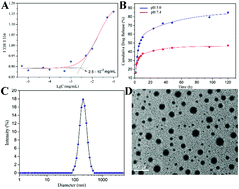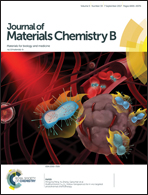pH-Responsive nanoparticles based on ibuprofen prodrug as drug carriers for inhibition of primary tumor growth and metastasis†
Abstract
Cancer metastases represent a major determinant of mortality in patients with cancer. Cyclooxygenase-2 (COX-2) and its metabolites play important roles in tumor growth and metastasis. Overexpression of COX-2 have been found in various types of cancers including melanoma. Nonsteroidal anti-inflammatory drugs (NSAIDs) have been widely used to inhibit COX-2 and can be a promising additive for the management of aggressive cancers. A novel pH-sensitive drug delivery carrier based on PEG-derivatized ibuprofen, MPEG-PHEI, was synthesized for dual delivery of anticancer agents and NSAIDs. This amphiphilic and biodegradable copolymer could self-assemble into core–shell nanoparticles (NPs) and the hydrophobic doxorubicin (DOX) could be loaded into the core of the nanoparticles. DOX-loaded MPEG-PHEI nanoparticles (DOX/NPs) could release DOX in endosome microclimate via micelle collapse and ibuprofen via ester bond hydrolysis. In vitro DOX/NPs showed comparable cytotoxicity to DOX·HCl and comparable inhibition of COX-2 to ibuprofen. More importantly, DOX/NPs revealed a significant in vivo therapeutic efficacy in both experimental subcutaneous tumors and lung metastasis model while decreasing the toxicity of DOX. This study demonstrated the advantages of combining NSAIDs with chemotherapy agents and provided a novel nanoparticle system for both primary and metastatic tumor treatment.



 Please wait while we load your content...
Please wait while we load your content...